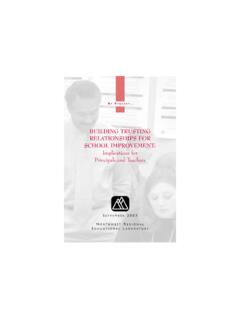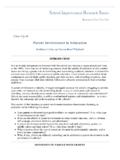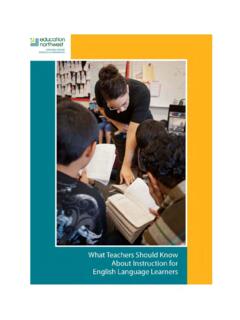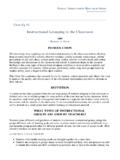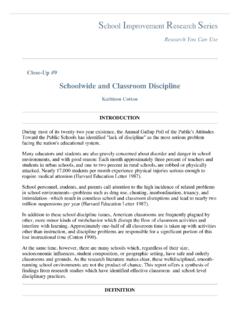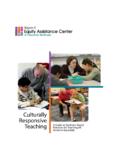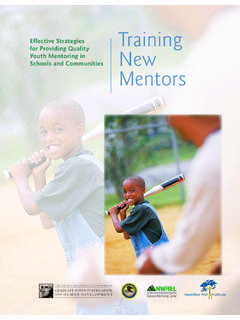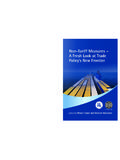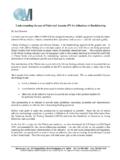Transcription of Sustainability Planning and Resource Development …
1 Effective Strategies for Providing Quality Youth Mentoring in Schools and CommunitiesSustainability Planning and Resource Development for Youth Mentoring ProgramsNational Mentoring CenterThis publication contains pages that have been left intentionally blank for proper pagination when September 2007 Published by: The Hamilton Fish Institute on School and Community Violence &The National Mentoring Center at Northwest Regional Educational LaboratoryWith support from:Office of Juvenile Justice and Delinquency Prevention, Department of JusticeYouth Mentoring in Schools and CommunitiesEffective Strategies for Providing Qualityand Resource Development for Youth Mentoring ProgramsPlannningPlannningSustainability SustainabilityHamilton Fish Institute on School and Community ViolenceThe George washington University2121 K Street NW, Suite 200, washington , DC 20037-1830Ph: (202) 496-2200E-mail: Fish Institute Director: Dr. Beverly Caffee GlennNational Mentoring CenterNorthwest Regional Educational Laboratory101 SW Main St.
2 , Suite 500, Portland, OR 97204 Toll-free number: 1-800-547-6339, ext. 135E-mail: Mentoring Center Director: Eve McDermottContributing Authors:Craig Bowman, Miki Hodge, Renee Hoover, Patti MacRae, Phyllis McGrath, Beth Senger, Dennis Wakeland, Dr. Susan G. WeinbergerEditor:Michael GarringerTechnical editor: Eugenia Cooper PotterLayout design:Dennis WakelandCover design:Paula Surmann 2008, National Mentoring CenterAll Rights Reserved This project was supported by the Hamilton Fish Institute on School and Community Violence through Award No. 2005-JL-FX-0157 awarded by the Office of Juvenile Justice and Delinquency Prevention, Office of Justice Programs, Department of Justice. Points of view or opinions in this document are those of the author and do not necessarily represent the official position or policies of the Department of Justice or the Hamilton Fish the Effective Strategies for Providing Quality Youth Mentoring in Schools and Communities SeriesiiiMentoring is an increasingly popular way of providing guidance and sup-port to young people in need.
3 Recent years have seen youth mentoring expand from a relatively small youth intervention (usually for youth from single-parent homes) to a cornerstone youth service that is being imple-mented in schools, community centers, faith institutions, school-to-work programs, and a wide variety of other youth-serving institutions. While almost any child can benefit from the magic of mentoring, those who design and implement mentoring programs also need guidance and support. Running an effective mentoring program is not easy, and there are many nuances and programmatic details that can have a big impact on outcomes for youth. Recent mentoring research even indicates that a short-lived, less-than-positive mentoring relationship (a hallmark of programs that are not well designed) can actually have a negative impact on participating youth. Mentoring is very much worth doing, but it is im-perative that programs implement proven, research-based best practices if they are to achieve their desired outcomes.
4 That s where this series of publications can Effective Strategies for Providing Quality Youth Mentoring in Schools and Communities series, sponsored by the Hamilton Fish Institute on School and Community Violence, is designed to give practitioners a set of tools and ideas that they can use to build quality mentoring programs. Each title in the series is based on research (primarily from the esteemed Public/Private Ventures) and observed best practices from the field of mentoring, resulting in a collection of proven strategies, techniques, and program structures. Revised and updated by the National Mentoring Cen-ter at the Northwest Regional Educational Laboratory, each book in this series provides insight into a critical area of mentor program Development :Foundations of Successful Youth Mentoring This title offers a comprehen-sive overview of the characteristics of successful youth mentoring pro-grams. Originally designed for a community-based model, its advice and Planning tools can be adapted for use in other Mentoring Program Policy and Procedure Manual Much of the success of a mentoring program is dependent on the structure and consistency of service delivery, and this guide provides advice and a customizable template for creating an operations manual for a local mentoring program.
5 Training New Mentors All mentors need thorough training if they are to possess the skills, attitudes, and activity ideas needed to ef-fectively mentor a young person. This guide provides ready-to-use training modules for your program. The ABCs of School-Based Mentoring This guide explores the nu-ances of building a program in a school Relationships: A Guide for New Mentors This Resource is written directly for mentors, providing them with 10 simple rules for being a successful mentor and quotes from actual volunteers and youth on what they have learned from the mentoring experience. Sustainability Planning and Resource Development for Youth Mentor-ing Programs Mentoring programs must plan effectively for their Sustainability if they are to provide services for the long run in their community. This guide explores key Planning and fundraising strate-gies specifically for youth mentoring programs. The Hamilton Fish Institute and the National Mentoring Center hope that the guides in this series help you and your program s stakehold-ers design effective, sustainable mentoring services that can bring positive direction and change to the young people you serve.
6 AcknowledgmentsThe National Mentoring Center (NMC) would like to thank the original authors of this publication for their insightful contributions: Mark Fulop, Dr. Susan G. Weinberger, Phyllis McGrath, Beth Senger, Craig Bowman, Miki Hodge, and Renee Hoover, and Patti MacRae and Dennis Wakeland for their contribution of new material. The content of this version was edited by Michael Garringer at the NMC. The NMC also thanks Scott Peterson at the Office of Juvenile Justice and Delinquency Prevention, Department of Justice for his support of the NMC and for mentoring in general. Finally, we thank the Hamilton Fish Institute on School and Community Violence at the George washington University for their support in developing and disseminating this revised pageviiContentsIntroduction .. 1 What Is Sustainability ? .. 1 About This Guidebook .. 3 Section I. Preparing for Resource Development Planning .. 5 Guiding Principles of Resource Development .
7 5 Getting Organized.. 10 Assessing Your Current Situation .. 13 Section II. Creating and Implementing a Resource Development Plan .. 21 Section III. Specific Funding Sources .. 33 Direct Support From Corporations and Business .. 35 Foundation Funding .. 41 Government Funding Sources .. 51 Individual Giving: Building a Powerful Constituency .. 65 Events and Other Local Support .. 83 AppendicesA The Role of the Board in Resource Development .. 93B Ethical Considerations in Fundraising .. 111C Worksheets and Tools for Planning .. 119D Additional Resources and Reading .. 127blank page1 IntroductionIntroductionAs youth mentoring has increased in popularity over the last decade, so has the competition for funds to support local men-toring programs. While mentoring programs come in all shapes and sizes from small grassroots efforts with shoe-string budgets to multimillion-dollar nonprofits all face the constant challenge of finding sufficient funds to deliver their services over time.
8 Mentor-ing programs face competition not only from each other, but from other youth-serving and social-profit organizations as well. With program staff focused on providing quality services to youth, Resource Development and Sustainability Planning are tasks that occasionally fall through the cracks. Even with concerted effort by program staff, the road to program Sustainability can be filled with unexpected challenges and tough guidebook is intended to give youth mentoring programs a basic overview of Resource Development Planning and many of the major funding sources that programs target through their Planning efforts. It is not intended to be a comprehensive guide to developing and main-taining a successful nonprofit or youth-serving organization (there are many factors other than Resource Development that make or break a successful organization). But it will give program staff some useful con-cepts and tools that can help them find the support they need, in many forms, to maintain their mentoring services over time.
9 What Is Sustainability ? Sustainability , capacity building, Resource Development , fundraising these are terms that often are used interchangeably to describe the work that nonprofit and youth-serving organizations do to survive and thrive. To begin our discussion of Sustainability it will be helpful to briefly define these terms and shed some light on how each is related to the other. Sustainability in the context of a mentoring program refers to the overall stability of the organization: its ability to weather temporary challenges, provide quality services in the present, and maintain a solid foundation for its future. Sustainability is affected by all the key activi-biSustainability Planning and Resource Development for Youth Mentoring Programs2ties and functions of an organization and all major activities are, in turn, affected by the ability of an organization to sustain itself. Capacity-building is the process by which an organization strengthens its foundations in order to increase its ability to carry out its mission.
10 Organizations can build their capacity by strengthening boards, build-ing technological resources, engaging volunteers, raising funds, build-ing partnerships, and developing staff skills and knowledge. Agencies with strong organizational capacity are more likely to be Development Planning is the intentional process of set-ting short- and long-range goals for obtaining the financial resources needed to support the organization. By Planning a set of activities to reach a stated goal, programs can avoid last-minute fiscal crises and haphazard responses to every new fundraising idea that comes along. The Resource Development plan offers a road map to fiscal gets down to the nuts and bolts of obtaining financial support to carry out the activities of a program or organization. It is one piece of capacity building albeit a very important one and is usually most successful when the agency has a well-developed orga-nizational capacity.
